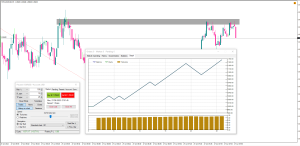Simulation
Simulating your trading is a very important part of your personal trading. Hedge Funds and institutions spend millions on simulations and back testing to find their edge in the market. Past results mean something, and this is why a lot of companies spend thousands on having powerful computers to record data. If you have ever had the chance to sit on an institutional trading floor you will soon realise this very quickly. Professional traders in suits looking over line charts, and data from the economy to predict the next move. Its like going back to school. However unfortunately this is part of your trading, you can not skip. Simulating your trading allows you to quickly find your edge in the market and build a set of rules for you to follow. I can not tell you how important this is to your future as a consistent trader. As a trader, you need to be able to consistently follow your rules and know what to do in every market situation. I have lost count of the amount of emails, I receive from traders asking me to help them, because they have lost 10% of their account or in 10% drawdown and panicking on what to do next. If they had done their simulation before hand, they would know exactly what to do as they would have written it down with a set of rules. The biggest wall you will have to face is when you switch from demo trading to live trading. The only difference between the both is one has the opportunity to make you real money, and lose you real money. Your emotions will kick in, and unless you are confident in your decision making and strategy, you will fail like the rest of them.
I doubt I would have ever discovered any kind of trading edge without extensively testing myself over historical data first. For me, the amount of time it takes to forward-test on live charts is extremely limiting. So when I am developing a new strategy I always turn to back testing. Through back testing I can test multiple strategies across multiple markets within a single week. I could devise an entirely new profitable trading plan within a month or two if I needed to. Back testing allows you to collect massive amounts of data and information about your strategy with minimal time. Of course, it can take dozens of hours to properly back test a strategy across all relevant markets. But that time is minimal compared to how long it would have taken to collect that data from live trades. Back testing historical data allows you to witness how your plan would have theoretically performed had you been trading it for the past few years. With this information you can objectively confirm whether or not what you plan to do in the markets will make you money, or lose you money.
During this course we will be simulating a lot, and we expect you to do the same too. Now when I say simulating I mean actually simulating and not scrolling back on the charts. There is big difference between scrolling back and simulating.
Scrolling Back on the Charts
The problem with scrolling back on your charts is it doesn’t give you a true result on what you may and may not do if it was live. You remember previously when we were talking about optical illusions and how some people may see a duck and others may see a rabbit, well that is exactly the same here. When you are scrolling back on the charts your subconscious mind will naturally spot the winning trades which is not necessarily a good thing, because in a live market its not always that easy to find a winning trade. In-fact you might not even be able to spot that winning trade if it was a live market. Looking back on the charts and seeing that winning trade is easy, but try spotting that live. That is the hard part! That is why you should never scroll back. Yes you can say this strategy produced 10 winning trades today, but what’s to say you would actually take those trades if it was a live market, or even be able to spot them.
Simulating
Simulating allows you to not only determine whether a strategy is profitable or not, but it will also allow you to build up the confidence to spot the setups live. When you are simulating, you do not know if a setup will win or lose and that becomes much harder for you to make your decisions. Also what happens if you decide to take a trade in simulation and price is struggling from your entry point? Do you close the trade in a small profit or let the trade run? That is something you have to learn yourself, and only simulating can do that for you. If you do not build up those skills before hand before going live, it will only end in blown accounts. This is why people panic when they go live, because in the back of their mind they have not built up the confidence yet. If you can comfortable build an account up in simulation, there is no reason why you should not be able to do that on a live market. The only difference would be your emotions.
Soft4fx Simulator
Soft4fx simulator is an MT4 simulator that I have personally used for nearly 5 years now. Out of all the simulators on the market, this is by far the best. Fx learning has partnered up with them and we now recommend it to all our members. Now this is not a plug to tell you to buy it, but as someone who uses it on a daily basis, I would highly recommend it. This simulator allows you to simulator any time or day going back weeks, months or even years. Not only can you simulate the market data, you can pause, rewind and even take trades too. On top of that it will also provide you a detail report telling you your win ratio, profit factor and overall account growth during that time period. There is nothing else like it on the market. The simulator makes it feel like a live market with all the features like placing trades or pending trades. You can even simulate multiply time frames at the same time. As someone who is learning the markets, its definitely something you should invest into. A couple of hours on the weekend with this, will save you so much time when it comes to the live charts during the week.
If you would like to learn more or even purchase the simulator, then simply click on the button below.
TradingView, MT5 & Ctrader
Unfortunately at the moment of writing this, we do not have an alternative for any of the other platforms. TradingView has a reply button which is great for short term simulating, but its not great if you want to simulate anything beyond a couple of days. Also it does not have the features like Soft4fx simulator does. There are some free ones available for Meta trader 5, but I have not personally used them to give them my approval.
Throughout this course though, we will be focusing a lot on simulating, and specially using the Soft4fx simulator to track our progress. I would recommend you invest into that simulator to get the best out of this course and your learning with us.
I will see you in the next section…



